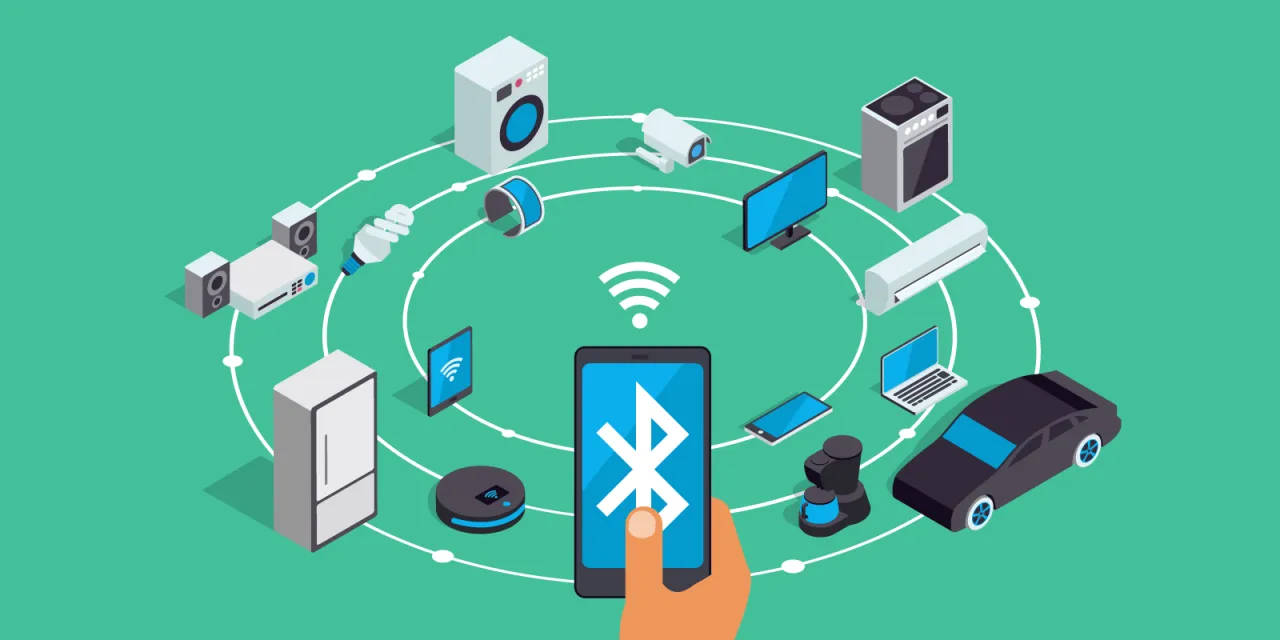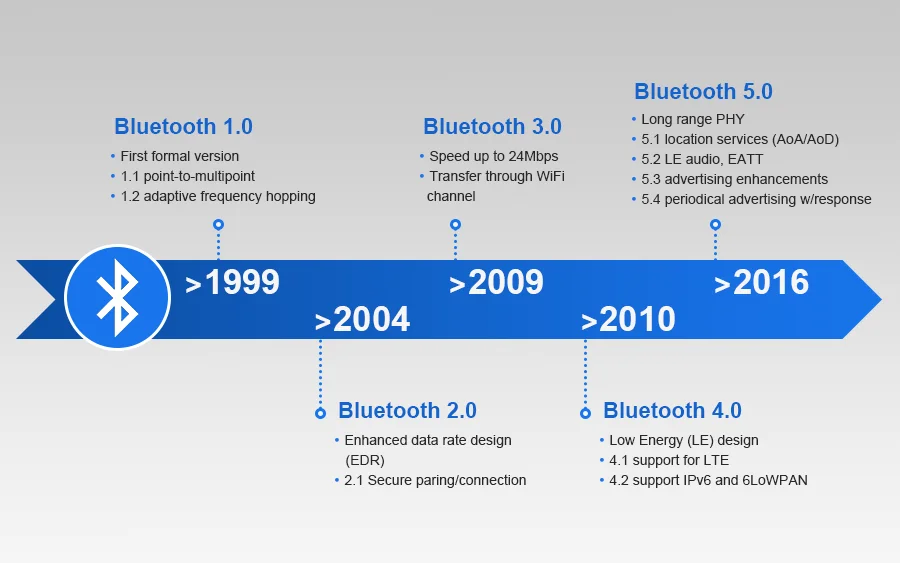Our wireless world depends on Bluetooth.
It connects our devices and shapes our tech lives.
Discover the secrets behind its latest versions.
Bluetooth 5.3 and Bluetooth 5.4 answer the need for smarter, more energy-efficient connections.
These versions bring new features to boost performance, enhance security, and improve IoT communication in everyday devices.
Our journey begins with an in-depth look at the core updates in Bluetooth 5.3 and 5.4.
Let us explore the changes and see how they can impact our daily tech experience.
What is New in Bluetooth 5.3?
Our tech world is always changing. Bluetooth 5.3 comes with features that make devices work better and use less energy.
Bluetooth 5.3 improves connection efficiency and lowers power use with features like Connection Subrating and enhanced channel classification.
It makes Bluetooth more reliable for devices such as wearables and smart home tools.

Bluetooth 5.3 introduces several new enhancements that set it apart from earlier versions.
First, it brings Periodic Advertising Enhancement.
This feature helps devices send out data in a controlled manner, reducing the need for repetitive scanning.
When a device receives redundant data, it can drop it quickly, saving energy.
This simple change helps many IoT devices, such as smartwatches and fitness trackers, last longer on a single battery charge.
Next, Bluetooth 5.3 adds Encryption Key Size Control Enhancements.
This update allows a host to set a minimum key size for encryption.
With this feature, devices can ensure that connections are secure from the start.
The improved encryption process means that data stays safe as it moves between devices.
This is important for devices that handle sensitive information.
Another significant feature is Connection Subrating.
This function allows a device to switch quickly between low and high duty cycles.
For example, a hearing aid may need to operate at a low power state most of the time but then switch to a higher power mode when a call comes in.
This fast switch enhances user experience by balancing power use and performance.
Bluetooth 5.3 also introduces Enhanced Channel Classification.
In past versions, only the central device could manage channel quality.
Now, peripheral devices can contribute to choosing the best channels, which reduces errors and improves connection stability.
Finally, the removal of the Alternate MAC and PHY (AMP) Extension simplifies the standard.
Although AMP had a niche use, its removal helps streamline Bluetooth’s operation, ensuring that the system remains robust and efficient.
Key Features Table of Bluetooth 5.3
| Feature | Description |
|---|---|
| Periodic Advertising Enhancement | Reduces redundant data processing and saves power. |
| Encryption Key Size Control | Sets minimum key size for secure connections. |
| Connection Subrating | Enables quick switching between low and high power modes. |
| Channel Classification Enhancement | Allows peripherals to help select the best channels. |
| AMP Extension Removal | Simplifies the protocol by removing rarely used features. |
These improvements make Bluetooth 5.3 ideal for many applications where energy saving and reliability are key.
The focus is on making sure that devices can maintain stable connections in crowded wireless environments, such as busy offices or public spaces.
With these changes, Bluetooth 5.3 is not just a minor upgrade; it is a step toward more efficient and secure wireless communication.
As a result, everyday devices can run longer and perform better, which is a significant win for both consumers and developers.
What is New in Bluetooth 5.4?
Bluetooth 5.4 is designed to meet the needs of large-scale IoT systems.
It introduces new ways to manage data and secure communications.
Bluetooth 5.4 brings major changes with Periodic Advertising with Responses (PAwR) and Encrypted Advertising Data.
It supports bidirectional, connectionless communication, making it ideal for smart IoT networks and advanced retail systems like Electronic Shelf Labels.

Bluetooth 5.4 expands the capabilities of wireless communication by focusing on IoT and secure advertising methods.
The first key innovation is Periodic Advertising with Responses (PAwR).
PAwR allows devices to engage in two-way communication without forming a full connection.
Traditionally, Bluetooth devices broadcast data in one direction.
With PAwR, a device can send data in scheduled time slots, and receivers can respond immediately in reserved slots.
This controlled method lowers power use because devices only listen during specific times.
It is a major benefit for battery-operated sensors that need to last for months or years.
Another important feature is Encrypted Advertising Data.
Before Bluetooth 5.4, encryption was only standard for connection-based communications.
Now, advertising data can also be encrypted. This change protects data from tampering and eavesdropping while still allowing devices to broadcast useful information.
For instance, a smart retail system using Electronic Shelf Labels (ESLs) can update prices securely without the risk of interference.
The data is split into encrypted and unencrypted sections.
Unencrypted parts, like device names, allow for easy identification, while sensitive parts are kept safe.
Bluetooth 5.4 also brings additional features such as the LE GATT Security Levels Characteristic.
This lets devices check if they meet the required security levels before exchanging data.
It prevents glitches during data transfers and ensures that only secure links are used.
Moreover, Advertising Coding Selection allows devices to choose the proper error correction level.
This selection improves the communication range and ensures that devices stay connected even in noisy environments.
Additional Key Features of Bluetooth 5.4
Bluetooth 5.4 brings several new benefits that enhance overall performance. Here are the key features:
- Higher Data Transmission: Bluetooth 5.4 supports higher data transmission without needing a direct connection. This is ideal for smart home devices and wearables that need to send more data quickly and efficiently.
- Simultaneous Device Connectivity: It allows more devices to connect at the same time. This improves user experience for items like headphones and smartwatches by reducing connection conflicts.
- Optimized Audio Transmission: The technology optimizes audio transmission for a more immersive experience. This is especially useful for headphones and gaming devices where clear, uninterrupted sound is critical.
- Improved File Transfer Speed: Bluetooth 5.4 boosts file transfer speeds, which increases efficiency when transferring larger amounts of data.
- Increased Signal Stability: It increases signal stability and resistance to interference. This ensures stable connections over longer distances, making it reliable in various environments.
- Enhanced Energy Management: The update improves energy management by lowering power use and extending battery life. This makes Bluetooth 5.4 devices more efficient and durable.
Detailed Feature Comparison Table
| Feature | Bluetooth 5.3 | Bluetooth 5.4 |
|---|---|---|
| Communication Mode | One-way broadcast with improvements | Bidirectional, connectionless via PAwR |
| Data Security | Enhanced encryption key control | Encrypted Advertising Data for secure broadcast |
| Power Management | Connection Subrating for low power modes | Optimized for large-scale IoT networks |
| Channel Management | Enhanced channel classification | Improved error correction with Advertising Coding Selection |
| Specific Use Cases | Wearables, smart homes, IoT devices | IoT networks, smart retail (ESL), sensor networks |
Bluetooth 5.4 is made for today’s connected world. It targets environments with many low-power devices.
A smart home or a warehouse with thousands of sensors can benefit from these changes.
The design ensures that devices are not only connected but also secure and efficient.
With PAwR, devices can handle small bursts of data in a controlled way, ensuring that battery life is maximized.
The system’s flexibility means it can switch to a more robust connection if more data needs to be sent.
This makes Bluetooth 5.4 a versatile solution for a range of applications.
The ESL profile is one example of how Bluetooth 5.4 can change business.
In retail stores, digital labels can update prices and product details quickly and securely.
The system is built to handle thousands of devices, all managed by a central Access Point.
A simple table of group IDs and device IDs helps manage the network efficiently.
This ease of management makes the technology attractive for large-scale deployments.
IoT Applications Table
| Application Area | Bluetooth 5.3 Suitability | Bluetooth 5.4 Suitability |
|---|---|---|
| Wearables | High (energy saving and stable connection) | Moderate (designed for quick response) |
| Smart Home Devices | High (efficient power use) | High (handles many devices with low power) |
| Industrial Sensors | Moderate (basic connectivity) | High (supports vast sensor networks) |
| Retail (ESL) | Low (not optimized for this use case) | High (standardized ESL profile) |
Bluetooth 5.4 also adds two smaller features that improve overall performance.
The LE GATT Security Levels Characteristic makes sure that a device meets the needed security level before accessing information.
This can prevent delays and glitches during connection setup.
Meanwhile, Advertising Coding Selection helps ensure that the correct error correction level is used when data is broadcast.
It is a small change, but it can have a big impact on reliability, especially in crowded environments.
Bluetooth 5.4 and App Integration for Earphones
Faster Connection Speed: Bluetooth 5.4 simplifies the pairing process by supporting quick pairing and auto-connection.
Users only need to power on their earphones and the app, and the connection completes without complex steps.
It also optimizes the connection mechanism, so the link is established faster, reducing waiting time.
More Stable Connection Experience: Bluetooth 5.4 enhances anti-interference capabilities to reduce signal drops and connection interruptions.
This ensures stable links between earphones and apps, even in crowded areas.
It also supports higher data rates and lower latency for smoother audio data and control commands, improving the overall user experience.
Richer Function Control: Bluetooth 5.4 supports a broader range of custom settings.
Users can personalize audio effects, touch controls, and noise-canceling options through the app, tailoring the listening experience to individual preferences.
It also enables integration with voice assistants or smart home devices for more intelligent interactions.
More Convenient Firmware Upgrades: Bluetooth 5.4 supports over-the-air firmware updates.
Users can download and install the latest firmware directly through the app, eliminating the need for a computer.
Regular firmware updates improve product performance and fix known issues, delivering ongoing optimizations to earphones.
Key Selling Points for Manufacturers:
- One-Tap Connection: Earphones power on and connect instantly, removing manual pairing steps.
- Stable Links Anywhere: Even in busy or noisy environments, the earphones maintain a reliable connection.
- Customizable Sound Profiles: Users can adjust EQ modes, touch gestures, and language options.
- Wireless Upgrades: Earphones receive firmware improvements without extra cables or hardware.
How Do Bluetooth 5.3 and 5.4 Compare?
The two versions bring different strengths.
They meet different needs in our connected world.
Bluetooth 5.3 and 5.4 each offer unique improvements.
Bluetooth 5.3 focuses on energy saving and stable connections, while Bluetooth 5.4 introduces bidirectional communication and secure advertising.
The choice depends on device needs and network size.

When comparing Bluetooth 5.3 and Bluetooth 5.4, it is important to note their core differences.
Bluetooth 5.3 emphasizes efficiency improvements and reliable data handling.
It uses features like Connection Subrating to manage energy use effectively.
This is a key factor for devices that run on small batteries.
The technology ensures that devices do not waste power when they are not active.
Enhanced channel classification further improves the connection by letting peripheral devices help choose the best channels.
This results in fewer dropped packets and smoother data flows.
In contrast, Bluetooth 5.4 is built for a more complex and connected world.
It introduces PAwR, which allows devices to send and receive data in a bidirectional, connectionless mode.
This is a shift from the traditional broadcast style. Devices now have scheduled time slots for both sending and replying.
This helps them manage energy much better and makes communication more efficient.
Moreover, Bluetooth 5.4 adds Encrypted Advertising Data.
This feature protects data even when devices are just broadcasting.
The security level is much higher, which is critical for IoT devices that often work in sensitive settings.
Comparative Analysis Table
| Comparison Aspect | Bluetooth 5.3 | Bluetooth 5.4 |
|---|---|---|
| Communication Mode | One-way broadcast with energy-saving features | Bidirectional with scheduled responses (PAwR) |
| Security | Improved encryption key size control | Standardized encryption for advertising data |
| Energy Efficiency | Uses connection subrating for low energy | Optimized for large networks and IoT devices |
| Use Case Focus | Wearables, smart home devices | Retail, sensor networks, extensive IoT setups |
To further highlight the differences, consider the case of True Wireless Stereo (TWS) earbuds.
Here, the improvements in Bluetooth 5.4 are particularly notable:
- Transmission Speed:
- TWS earbuds with Bluetooth 5.4 outperform those with Bluetooth 5.3 in terms of transmission speed and stability. With reduced latency around 60-70ms, Bluetooth 5.4 provides faster data transfer, ensuring smoother audio streaming and calls.
- Power Efficiency:
- Devices using Bluetooth 5.4 consume less power. This extends the battery life of TWS earbuds, meaning longer playback time on a single charge and more energy-efficient performance overall.
- Extended Range:
- Bluetooth 5.4 earbuds also offer a wider range than their Bluetooth 5.3 counterparts. This enhanced range improves connectivity stability in different environments and reduces the chances of dropouts, even when the paired device is farther away.
- Enhanced Audio Quality:
- TWS earbuds with Bluetooth 5.4 deliver audio with greater clarity and detail. This improvement results in a more immersive listening experience with richer sound and less distortion.
- Future Potential:
- Bluetooth technology continues to evolve. Future updates in Bluetooth 5.4 are likely to introduce further features that enhance the TWS experience, particularly in energy efficiency, connectivity, and audio quality.
TWS Comparison Table
| Aspect | TWS with Bluetooth 5.3 | TWS with Bluetooth 5.4 |
|---|---|---|
| Transmission Speed | Standard speed and stability | Faster speed with reduced latency (60-70ms) |
| Power Efficiency | Good battery life | Extended battery life due to lower power usage |
| Range | Standard connection range | Extended range for improved connectivity |
| Audio Quality | Good sound quality | Enhanced clarity and detail for immersive audio |
| Future Potential | Limited further improvements | More updates expected to boost overall performance |
These comparisons show that while both versions share common basics, Bluetooth 5.4 steps up with significant improvements in several key areas.
Its enhancements in transmission speed, power efficiency, range, and audio quality make it an attractive option for modern IoT devices, especially TWS earbuds.
The added future potential also indicates that Bluetooth 5.4 will likely lead the way in upcoming wireless innovations.
What Are the Practical Implications and Future Trends?
Modern technology choices affect everyday life. Choosing the right Bluetooth version can change how devices perform and interact.
Bluetooth 5.3 and 5.4 pave the way for smarter devices.
Their improvements in energy use, security, and connectivity shape the future of IoT, smart homes, and industrial applications.
They bring new opportunities for innovation and efficiency.

The practical implications of these Bluetooth updates reach far and wide.
For instance, Bluetooth 5.3’s energy-saving features make it an excellent choice for devices that need to run for long periods on a single battery charge.
This is crucial for wearables like fitness trackers and smartwatches.
When a device can efficiently manage power, users experience fewer interruptions and longer device life.
The improved channel classification also ensures that data is reliably transmitted even in noisy environments.
This makes Bluetooth 5.3 well-suited for urban areas, busy offices, and crowded public spaces.
On the other hand, Bluetooth 5.4 introduces features that are geared toward the needs of large IoT networks.
With PAwR, devices in a smart city or a large retail setting can communicate quickly and securely without forming full connections.
This is a breakthrough for applications that require rapid, two-way communication without the burden of continuous connectivity.
The encrypted advertising data feature enhances security, which is essential as more devices become part of the network.
In settings like smart retail, where digital shelf labels update in real time, security is paramount to protect sensitive data.
Future Trends Table
| Future Trend | Impact on Bluetooth 5.3 | Impact on Bluetooth 5.4 |
|---|---|---|
| IoT Device Growth | Better battery life for wearables and sensors | Support for thousands of connected devices |
| Urban Connectivity | Improved reliability in crowded areas | Enhanced secure broadcasts for smart cities |
| Retail and Automation | Limited by one-way broadcast methods | Full bidirectional communication and security |
| Industrial Applications | Sufficient for basic sensor networks | Optimized for large-scale industrial IoT networks |
As we look to the future, the choice between Bluetooth 5.3 and 5.4 may come down to the specific needs of a project.
For instance, a startup developing a new wearable device may lean toward Bluetooth 5.3 to ensure long battery life and steady performance.
In contrast, a large enterprise building a smart retail system might prefer Bluetooth 5.4 to take advantage of its robust bidirectional communication and secure advertising features.
Developers will choose the version that best fits their needs, and consumers will enjoy more reliable, secure, and efficient devices.
The real winner is the consumer, who gets more capable devices that work seamlessly in our connected world.
Practical Implications Table of Use Cases
| Use Case | Best Suited Version | Reason |
|---|---|---|
| Wearables and Fitness Trackers | Bluetooth 5.3 | Energy efficiency and stable connections |
| Smart Home Automation | Bluetooth 5.3/5.4 | Depends on the scale; both offer energy savings |
| Retail (Electronic Shelf Labels) | Bluetooth 5.4 | Secure, bidirectional communication via PAwR |
| Industrial IoT Networks | Bluetooth 5.4 | Supports large device networks and improved security |
Conclusion
Bluetooth 5.3 and 5.4 each bring vital improvements.
Their innovations boost efficiency, security, and connectivity for today’s smart devices.
For Manufacturers:
When promoting earphones or similar products, highlight Bluetooth 5.4’s rapid connection setup, stable signal, and convenient firmware updates.
Emphasize how these features offer a seamless user experience, reduce customer complaints about pairing, and enable ongoing improvements through wireless upgrades.
This positions your product as forward-thinking and reliable, meeting consumer demands for effortless connectivity and future-ready functionality.

